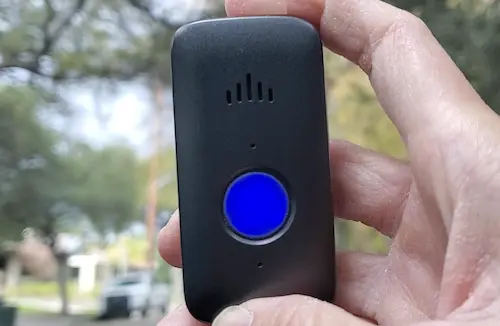Last Updated on October 11, 2023
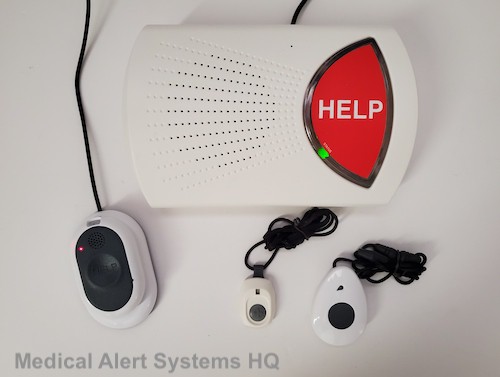
When selecting a medical alert system, one metric that is often misunderstood is Range.
Perhaps you’ve seen systems being advertised as the “best” because they have the longest range. You may have seen companies quoting impressive maximum range numbers of anywhere from 1,000 ft to 1,500 ft in their advertising (wow, 3 – 5 football fields in length!).
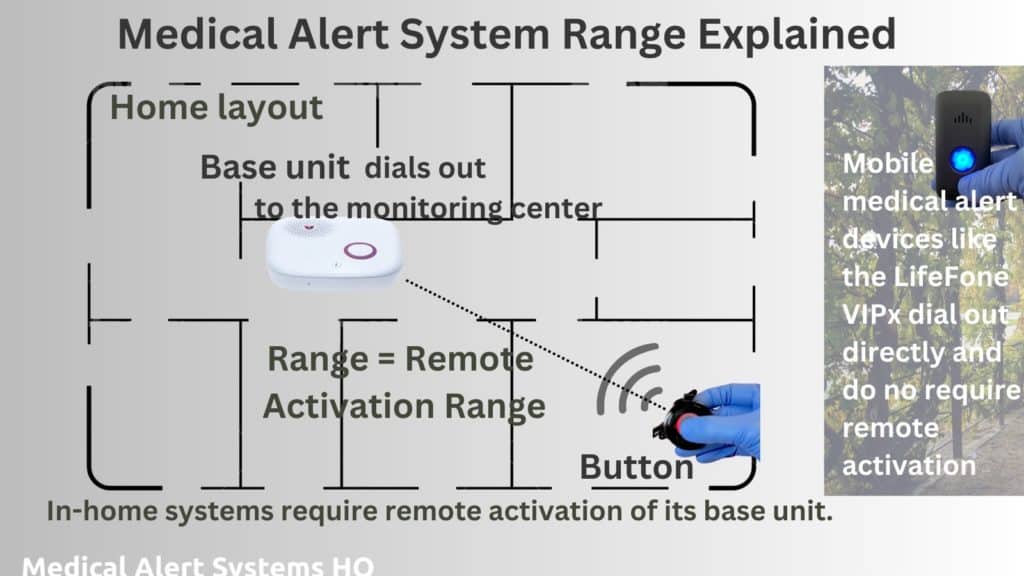
One may be tempted to think that the long system range will provide sufficient coverage both at home and around the neighborhood.
Unfortunately, that’s not true.
In this article, I will explain what range means when used to describe long-range medical alert systems. That allows you to decide how to approach it as a decision-making factor when choosing the right medical alert product.
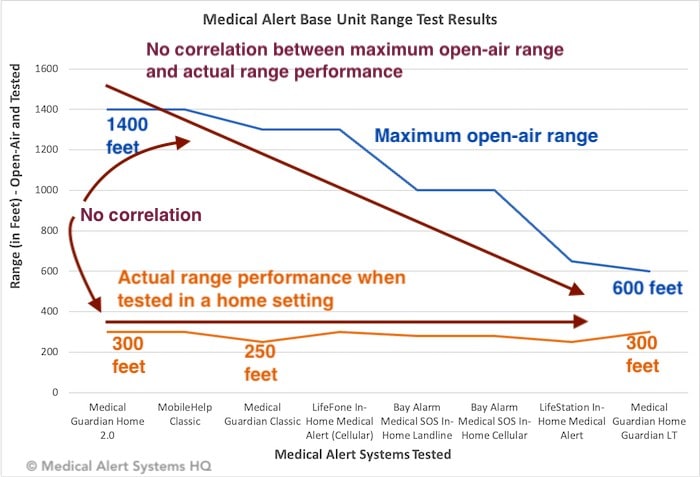
For starters, the impressive 1000 feet – 1500 feet numbers are based on open-air measurements, where there is a clear line of sight and zero obstacles. In a real life environment, the actual range will be much less. In our testing, we found that on average, the actual range performance is just 26% of the full open-air range.
We found little correlation between the actual range performance and the maximum range in an open field as advertised. Whether it’s 600 feet or double that, the actual performance was similar at around 250 to 300 feet.
Remote Activation Range
When you see a medical alert system marketed as long-range (eg. “we have the longest range system at up to 1,500 ft in range”), the range described refers to the remote activation range. That is, how far away the remote transmitter button (also known as medical alert button or help button) can be from the in-home base unit for a call activation signal to still go through successfully.
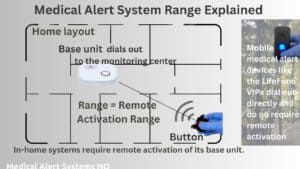
If you are far away, you may still be able to remotely activate an alert on the base unit. (However, you may not be able near enough to the base unit, which contains the speakerphone, to communicate with the operator. We’ll cover voice range below.)
Contrast that with an all-in-one mobile device (example above), where the help button and speakerphone are all contained without one device. You will be pushing the button right on the device itself, and communicating with the operator through the device.
What you get is a mobile device that works wherever the cellular signals are strong enough. Much like a cell phone. There is no comparable maximum range number associated with these all-in-one mobile device since there is no remote activation.
Activation Range vs. Voice Range
Remote activation range is also different from the voice range of the system; ie. how far away from the base unit you could be, to still be able to verbally communicate with the monitoring operator.
The speaker and microphone are contained within the base unit, not the medical alert button.
When you close the door and step away from home, chances are that it will be very difficult to establish voice contact through the base unit. Even if your medical alert help button successfully transmits an activation signal, it does not mean that you will be able to speak to the operator.
(That might still be OK if you are just outside the home. The first responders or your emergency contact will likely spot you when they arrive.)
Let’s go through two examples to make this clearer.
Let’s say, Mary, a medical alert subscriber, slips in the shower and needs help. She pushes on her necklace button to activate a medical alert call through the base unit.
Perhaps the base unit is in another room. These base units have sensitive speakers and microphones, so it’s possible that she can still establish a two-way conversation with the operator. (To be certain that it works for you, you will need to test this in your home. If you can communicate with the operator, you are still within voice range.)
Even if the operator can’t hear the subscriber (ie. system is out of voice range), Linda’s location is fixed to her home address, as she is calling through an in-home system. The operator will know to send help to her home.
Let’s look at another example. Suppose Mary subscribes to a long-range system with a specified a maximum range of 1,200 feet. She takes frequent walks around the neigborhood.
One evening while out strolling, she suddenly feels dizzy in an obscure spot nearby. Needing help, she pushes on the button, and the call successfully goes through on the base unit at home (despite all the environmental obstacles).
Unfortunately, as she is a distance from home, she is out of voice range. She is unable to let the operator know where to send help to.
Since this is an in-home system, the operator dispatches emergency responders to her home, where the responders aren’t able to find her. Fortunately, Mary was not in a critical situation. The medical alert company also contacted Mary’s daughter, who later found Mary and brought her to the hospital.
Coverage Away From Home
Perhaps you are looking for a “long-range” system because you need something that works beyond the perimeter of your home. In that case, your needs are best served by a mobile on-the-go medical alert device.
These are smaller, portable devices that work both in and out of the home. They typically come with a speaker and microphone right on the button device itself and include location services (eg. GPS) to indicate the location of the device.
They work wherever their built-in cellular connectivity allows them to, whether at home or outside. Connectivity is usually provided through AT&T or Verizon wireless networks, and the service comes bundled with the device (ie. no extra cell phone line needed).
Summary Takeaways
1. An in-home medical alert system is good for in-home coverage only. If the distance from one end of your home to the other is 60 feet, you will very likely have sufficient coverage whether it’s 600 ft system or a 1200 ft system (always test your system out after purchase, do not go by what’s theoretically possible!!). The range metric measures remote activation range between an in-home system help button and the base unit.
2. With an in-home medical alert system, the subscriber’s location is tied to the address where the system is registered to be at, not the place where they pushed the button from.
3. In contrast, a mobile medical alert offers coverage both at home and away from home. The help button, speaker, and microphone are contained within one device. The device is usually worn or else kept close to the subscriber.
4. If you are looking for a button that works when you leave home, you will need a mobile device, not a long-range in-home system.
5. Looking for an in-home medical alert system? A longer stated maximum range does not automatically mean that the system has a better reach, based on our test results. In a follow-up article, I will share my experience and results testing out the activation range performance of various in-home systems.
The Range of a medical alert system is often a decision-making factor in selecting the right product. It’s important to understand what the Range metric means in the right context. Here are additional examples of the best long range medical alert systems.
- Bay Alarm Medical In-Home Cellular Response Speed 46% Faster in 2023 - July 5, 2023
- Medical Alert Systems For Landlines - November 20, 2022
- The Truth About Long-Range Medical Alert Systems - May 1, 2022

